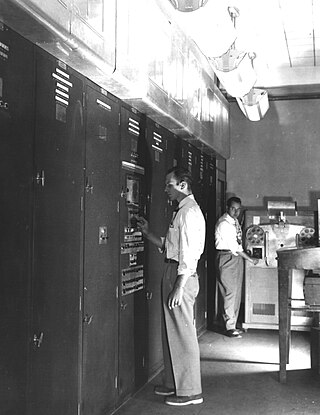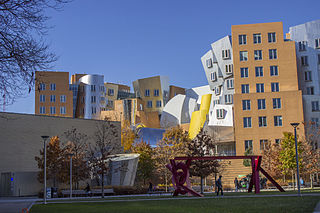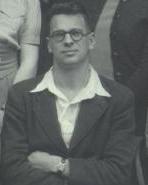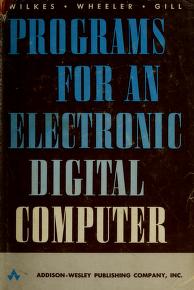
The Electronic Delay Storage Automatic Calculator (EDSAC) was an early British computer. Inspired by John von Neumann's seminal First Draft of a Report on the EDVAC, the machine was constructed by Maurice Wilkes and his team at the University of Cambridge Mathematical Laboratory in England. EDSAC was the second electronic digital stored-program computer to go into regular service.

The history of computing hardware covers the developments from early simple devices to aid calculation to modern day computers.

The LEO was a series of early computer systems created by J. Lyons and Co. The first in the series, the LEO I, was the first computer used for commercial business applications.

EDVAC was one of the earliest electronic computers. It was built by Moore School of Electrical Engineering, Pennsylvania. Along with ORDVAC, it was a successor to the ENIAC. Unlike ENIAC, it was binary rather than decimal, and was designed to be a stored-program computer.

Stata Center, officially the Ray and Maria Stata Center and sometimes referred to as Building 32, is a 430,000-square-foot (40,000 m2) academic complex designed by Pritzker Prize-winning architect Frank Gehry for the Massachusetts Institute of Technology (MIT). The building opened for initial occupancy on March 16, 2004. It is located on the site of MIT's former Building 20, which had housed the historic MIT Radiation Laboratory, at 32 Vassar Street in Cambridge, Massachusetts.

Sir Maurice Vincent Wilkes was a British computer scientist who designed and helped build the Electronic Delay Storage Automatic Calculator (EDSAC), one of the earliest stored program computers, and who invented microprogramming, a method for using stored-program logic to operate the control unit of a central processing unit's circuits. At the time of his death, Wilkes was an Emeritus Professor at the University of Cambridge.

The Manchester Baby, also called the Small-Scale Experimental Machine (SSEM), was the first electronic stored-program computer. It was built at the University of Manchester by Frederic C. Williams, Tom Kilburn, and Geoff Tootill, and ran its first program on 21 June 1948.

The Department of Computer Science and Technology, formerly the Computer Laboratory, is the computer science department of the University of Cambridge. As of 2023 it employed 56 faculty members, 45 support staff, 105 research staff, and about 205 research students. The current Head of Department is Professor Ann Copestake.

The University of Cambridge Computing Service provided computing facilities across the University of Cambridge between 1970 and 2014. It was located primarily on the New Museums Site, Free School Lane, in the centre of Cambridge, England but, in September 2013 moved to the Roger Needham Building on the West Cambridge site.

David John Wheeler FRS was a computer scientist and professor of computer science at the University of Cambridge.

OXO is a video game developed by A S Douglas in 1952 which simulates a game of noughts and crosses (tic-tac-toe). It was one of the first games developed in the early history of video games. Douglas programmed the game as part of a thesis on human-computer interaction at the University of Cambridge.

Douglas Rayner Hartree was an English mathematician and physicist most famous for the development of numerical analysis and its application to the Hartree–Fock equations of atomic physics and the construction of a differential analyser using Meccano.
John Makepeace Bennett was an early Australian computer scientist. He was Australia's first professor of computer science and the founding president of the Australian Computer Society. His pioneering career included work on early computers such as EDSAC, Ferranti Mark 1* and SILLIAC, and spreading the word about the use of computers through computing courses and computing associations.
Andrew James Herbert, OBE, FREng is a British computer scientist, formerly Chairman of Microsoft Research, for the Europe, Middle East and Africa region.
Professor Stanley J. Gill was a British computer scientist credited, along with Maurice Wilkes and David Wheeler, with the invention of the first computer subroutine.
Ralph Anthony Brooker, was a British computer scientist known for developing the Mark 1 Autocode.
David William Barron FBCS was a British academic in Physics and Computer Science who was described in the Times Higher Education magazine as one of the "founding fathers" of computer science.
Beatrice Helen Worsley was the first female Canadian computer scientist. She received her Ph.D. degree from the University of Cambridge with Maurice Wilkes as adviser, the first Ph.D. granted in what would today be known as computer science. She wrote the first program to run on EDSAC, co-wrote the first compiler for Toronto's Ferranti Mark 1, wrote numerous papers in computer science, and taught computers and engineering at Queen's University and the University of Toronto for over 20 years before her death at the age of 50.

David Fielding Hartley FBCS is a computer scientist and Fellow of Clare College, Cambridge. He was Director of the University of Cambridge Computing Service from 1970–1994, Chief Executive of United Kingdom Joint Academic Network (JANET) 1994–1997, and Executive Director of Cambridge Crystallographic Data Centre (CCDC) 1997–2002. He is now much involved with the National Museum of Computing.

The Preparation of Programs for an Electronic Digital Computer was the first book on computer programming. Published in 1951, it was written by Maurice Wilkes, David Wheeler, and Stanley Gill of Cambridge University. The book was based on the authors' experiences constructing and using EDSAC, one of the first practical computers in the world.















